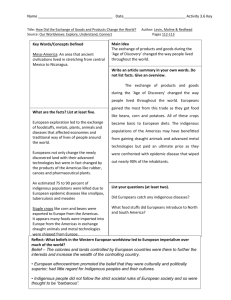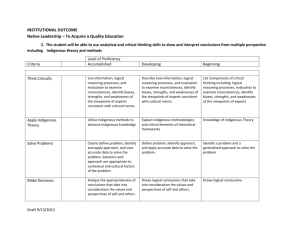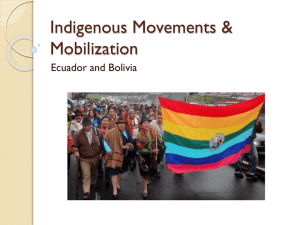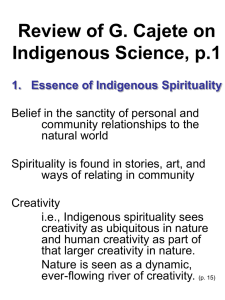Abstract
advertisement
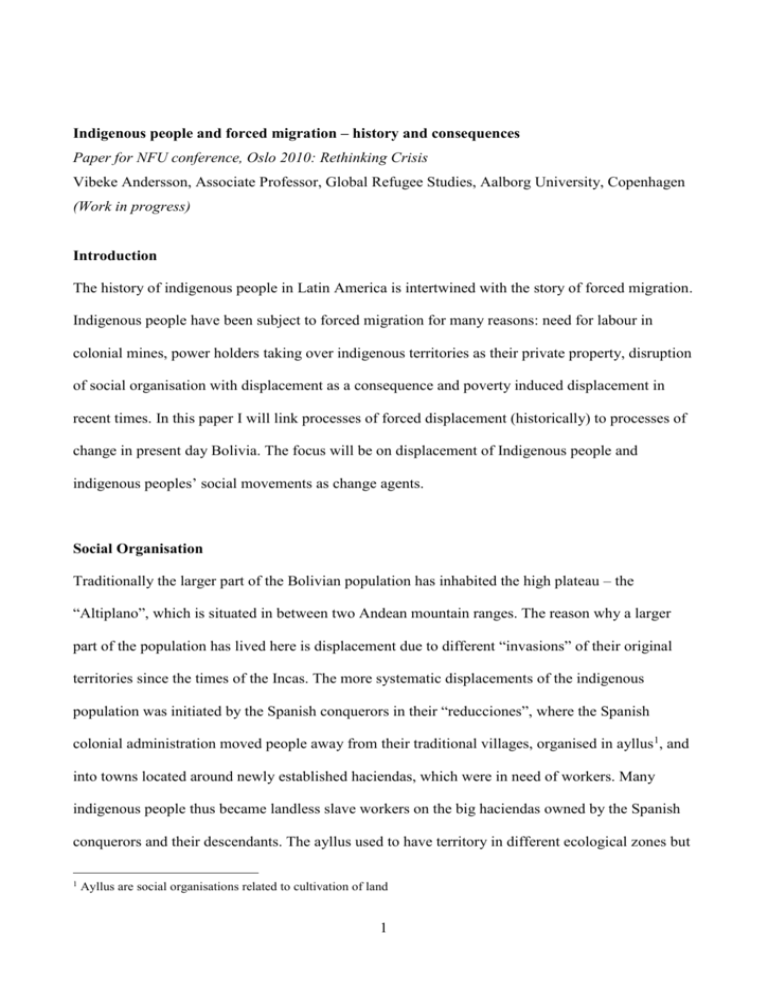
Indigenous people and forced migration – history and consequences Paper for NFU conference, Oslo 2010: Rethinking Crisis Vibeke Andersson, Associate Professor, Global Refugee Studies, Aalborg University, Copenhagen (Work in progress) Introduction The history of indigenous people in Latin America is intertwined with the story of forced migration. Indigenous people have been subject to forced migration for many reasons: need for labour in colonial mines, power holders taking over indigenous territories as their private property, disruption of social organisation with displacement as a consequence and poverty induced displacement in recent times. In this paper I will link processes of forced displacement (historically) to processes of change in present day Bolivia. The focus will be on displacement of Indigenous people and indigenous peoples’ social movements as change agents. Social Organisation Traditionally the larger part of the Bolivian population has inhabited the high plateau – the “Altiplano”, which is situated in between two Andean mountain ranges. The reason why a larger part of the population has lived here is displacement due to different “invasions” of their original territories since the times of the Incas. The more systematic displacements of the indigenous population was initiated by the Spanish conquerors in their “reducciones”, where the Spanish colonial administration moved people away from their traditional villages, organised in ayllus1, and into towns located around newly established haciendas, which were in need of workers. Many indigenous people thus became landless slave workers on the big haciendas owned by the Spanish conquerors and their descendants. The ayllus used to have territory in different ecological zones but 1 Ayllus are social organisations related to cultivation of land 1 now this was split up. Having plots of land in the high plateau, the valleys and the tropical lowlands, secured the members of the ayllus many different products: potatoes and quinoa2 from the high plateau, wheat, cotton and corn from the valleys and tropical fruits from the lowlands. The ayllus persisted after the reducciones, but now they were only having territory at the altiplano, which excluded them from growing the diverse products in the different ecological zones, and also it altered the social organisation, which was tying together the extended ayllu. Nevertheless the social organisation connected to the technology of cultivating the land commonly in the high plateau persisted. A large part of the indigenous population continued to live in the altiplano while other parts of the lower areas of Bolivia were sparsely populated. Being members of a social organisation also strengthened the indigenous population internally, and organising and uniting has been a trend in the Bolivian social movements over the centuries. After the 1952 revolution organising in unions became common since to be granted a piece of land after the land reform, a person had to be member of the peasant union. In the cities workers formed unions and the mine worker union gained great power within the central workers union, COB (Central Obrera Boliviana). This power diminished after 1982 when Bolivia’s economic problems increased due to a fall of tin prices on the world market. Tin was Bolivia’s main export good. In 1985 then President Paz Estensorro introduced a structural adjustment program. This opened the process of the neo liberal structural adjustment policies. The objective was to stop inflation, which was accomplished, but the policies were a blow to social organisations and unions, depriving these of influence in Bolivian society by privatizing state-owned industries. Before 1985, the Bolivian unions were very strong and the State provided at least 60% of the country’s employment. Among the state-owned industries were petroleum, telecommunications, airlines, railroads and mines. The 2 Quinoa is a special and very nutritious type of plant which provides the Andean population with grains for multiple purposes. 2 mining sector was very important, and four mines produced 25 percent of the states’ total revenue3. Many of these industries have been privatized, others have been closed down due to economic crisis, and the unions have lost their importance and strength. With the economic collapse of especially the tin industry in the beginning of the 1980’s the mining industry lost its importance for Bolivian economy, and the mine workers were fired. This initiated a massive migration to the lower areas of Bolivia. Many mine workers were forcibly moved to Chapare, the tropical western part of Bolivia. In Chapare many of them settled as coca farmers. The US led “war on drugs” in Bolivia, which includes eradication of coca plants and fields, has led to decrease in drug money – including the money which small scale peasants received by selling the coca leaves – and thereby an increase in the dependency on foreign aid and support from international financing institutions like the World Bank and other donors. The “war against drugs” initiated by the Bolivian government helped by the US created social instability in Bolivia for decades, and is a consequence of poor farmers growing coca as a cash crop in order for them and their families to survive. In fact the coca production has also increased income for Bolivia.The coca leaf is a plant, which has been used traditionally for centuries by the indigenous people in the Andean region. Therefore the protests against the war on drugs also have cultural connotations since the coca leaf is part of many indigenous people’s traditions and culture. Hybridity The policies of the coca-leaf producers and their leaders can be explained by the notion of “hybridity”: “Constant articulation of differing cultural discourses […]. This has been quite evident in the practices of these movements in which local, national and trans-national, non-modern and 3 Multinational Monitor, 2000 3 modern are continually interwoven” (Stolle-McAllister, 2005:28). Even though the notion of hybridity could further lack of difference it can on the other hand be used to analyse social movements which change over time i.e. the members of coca-leaf producers’ organisation who are themselves indigenous people. At one time in history they “use” the class based discourse and form an old social movement, which gradually transfer to a new social movement putting emphasis on the indigeneity instead of class struggle, but still representing the same people and their interests. Stressing the indigenous cultural identity is a common trend throughout Latin America today. Due to the growing Indian rights mobilization an increase in ethnic identification and cultural pride is taking place (Brysk, 2000). Regarding the notion of hybridity, activists often claim that their struggle is concentrated on a certain issue and “reality” only relevant for their own particular situation. In Bolivia the fights for indigenous rights could be one example, and here in particular the fight for rights to land. Although this fight may seem very “local”, where opponents like hacienda owners and other large landowners also have an interest in the land – or in the forest areas where settlers and large timber companies also claim the land. This “local” fight for land in not only local, but is connected to the national and international levels in many ways. Thus the fight gets “simultaneously local, global and national, which is reflected in their seemingly contradictory demands both for autonomy and for greater inclusion.” (Stolle-McAllister, 2005:7). In Bolivia this wish for both autonomy and greater inclusion by the indigenous people can take new forms given the fact that even though the indigenous population in relation to power has been a minority, in numbers they form the majority of the Bolivian population. Formerly the articulation of the indigenous social movements has been within class discourse. Now cultural articulation has “switched” to stressing the indigenous past and rights of indigenous people. This argument will be further developed later in this paper. 4 Displacement and social change The main argument in this paper is that displacement has been a key factor in ‘provoking’ changes in Bolivia. As mentioned above people have been moved around by power holders since the empires of the Incas and Europeans. But the recent forced migration from highland mining centres to lowland tropical forest regions has encouraged social change in a different way than before. With this migration social movements have gained momentum which has lead to many different struggles around Bolivia for the last 20 years from unions’ protest over closing down mines and ‘march for coca and dignity’ to ‘water and gas’ wars due to increased prices, which have resulted in more encouragement for further struggle by social movements. Especially the displaced miner workers from highland mining areas and their movement, has resulted in social change in Bolivia. In migrating from mining areas and work to lowland Chapare, the miners had to change their livelihood in quite many ways. First of all they were given plots of land to cultivate, second og all they were moved from their original villages to form new villages in the Chapare rain forest. This led to changes in their understanding of identity as well. In the mining area the identity as worker within a class based social structure was strong. The miners union has always been the activist group of the labour unions in Bolivia. Also the subsistence farmers of the rural areas were members of the union. As mentioned before the MNR revolutionary government was distributing land to former workers of the haciendas after the revolution in 1952 and the new farmers had to become members of the union in order to receive land. So class based unions have been strong actors in Bolivia from 1952. In the mid-1990s, more identity based social movements were formed– also in Bolivia. A shift from class based movements to identity-based unions has taken place worldwide (Mayo 2005), and in Bolivia this has especially been visible in the resurgence of indigenous 5 movements which were supported by international civil society (especially NGOs and UN) through the ‘rights based approach’. This shift meant shift in discourse and form of organisation, which the model below shows. From Discourse: To Miner (employee) Indigenous People or Campesino (subsistence farmer) Organisation: Indigenous Peoples’ Union Organisations Ownership to land Individual Collective This shift in organisation and discourse also influenced the former miners, who were forcibly moved to the lowlands to become farmers. In their organisation they began to emphasize the identity and culture as indigenous people, especially after they shifted from producing fruit and vegetables to producing coca leaves. The reason behind this shift was partly that the production of fruit and vegetables was not economically feasible, since there were for example no infrastructure helping bringing products to markets. The cultivation of coca, on the other hand was easy to do and the product is easy to transport, since coca leaves weigh very little. For many reasons coca became the primary product of the former miners now living in Chapare. And in struggling against the US led ‘war against drugs’ which meant that the army was cutting down coca plants in Chapare, the coca producers union was emphasizing the cultural value of the coca leaf, which has been cultivated in the Andean area for centuries and which has traditional and religious value to Andean indigenous 6 people. This way the former strong union structure was merged with a new indigenous discourse which caught the attention of the Bolivian population in an unprecedented way. Evo Morales was elected as leader of the coca-leaf farmers before his election to president. As a leader of the union he has stressed class discourse when fighting for coca leaf producers’ rights. This fight was mostly directed against the US supported coca plant eradication programs in the Chapare region. The reason why the US government has supported the Bolivian government in their coca plant eradication strategy has been their allegation that most of the coca grown in Chapare has been sold to the illegal cocaine industry. Evo Morales, on the other hand, has stressed the cultural importance of coca and its importance for indigenous culture and tradition. As a union leader his rhetoric has been definitive, but after being elected as president he has softened it some, now declaring “yes to coca, no to cocaine”. Being tied to coca-leaf production, the coca peasant union has played on two strings in its organisation and political project. One being the class based rhetoric of a social movement linking its fight to the class based society and organising within this. The other string has being the cultural one. He has been linking the coca-leaf production to Bolivian culture and traditions and this way arguing for the right to grow coca, despite the fact that Bolivian governments and US administrations at one point declared the coca-leaf production in Chapare illegal. One can see a development in the coca-leaf farmers union from the rhetoric of the “old” social movements towards the rhetoric of the “new” social movements. Swinging from obtaining rights on a class based focus on division of wealth to focusing on indigenous people and their rights - for example the right to grow coca as indigenous people – in line with the growing of coca in the legal areas of Yungas. New social movements put emphasis upon “issues of identity, ideology and culture, issues of social integration and social and cultural reproduction rather that upon the material issues around 7 production and distribution that had been seen as the bread and butter of class conflict in capitalist societies” (Mayo, 2005: 62). The main argument of this paper is that this merger of class based organisation and identity based rhetoric (hybridity) was created because of the forced migration of large groups of miners from the highland to the Chapare region. This forced migration thus lead to political and social change with the election of South America’s first indigenous president, Evo Morales. Conclusion Forced migration most often leads to loss of livelihoods and rights (Robinson 2002). In the case presented in this paper the loss of livelihoods and rights has also been the case. But in addition to this the forced population from the Bolivian highlands can be seen as a type of ‘change agents’ who in a new setting and under new circumstances were active in starting social processes (along with other social groups and movements) which led to changes on a national level. References Brysk, Alison: From Tribal Village to Global Village. Indian Rights and International Relations in Latin America. Stanford, California, 2000. Jeppesen, Anne Marie Ejdesgaard: Using the Past to Construct Present Identities: Memories of Bolivian Ex-Miners. In: Historia y Sociedad en los Andes, Siglos XIX y XX, Vol 15 No.1, eneroJunio 2004. Estudios Interdisciplinarios de America Latina Y El Caribe, 2004. Mayo, Marjorie: Global Citizens. Social movements & the challenge of globalization. Zed Books, London 2005 8 Postero, Nancy Grey: Now we are citizens. Indigenous politics in Postmulticultural Bolivia, Stanford, California, 2007 Robinson, Jenny: Development and Displacement, Oxford 2002 Stolle-McAllister, John: Mexican Social Movements and the Transition to Democracy. McFarland & Company, Inc. Publishers, 2005 Urban, Greg & Joel Sherzer: Nation-States and Indians in Latin America, University of Texas Press, 1991. Van Cott, Donna Lee: Indigenous People and Democracy in Latin America, MacMillan Press, 1994. Van Cott, Donna Lee: From Movements to Parties in Latin America, Cambridge, 2005. 9



